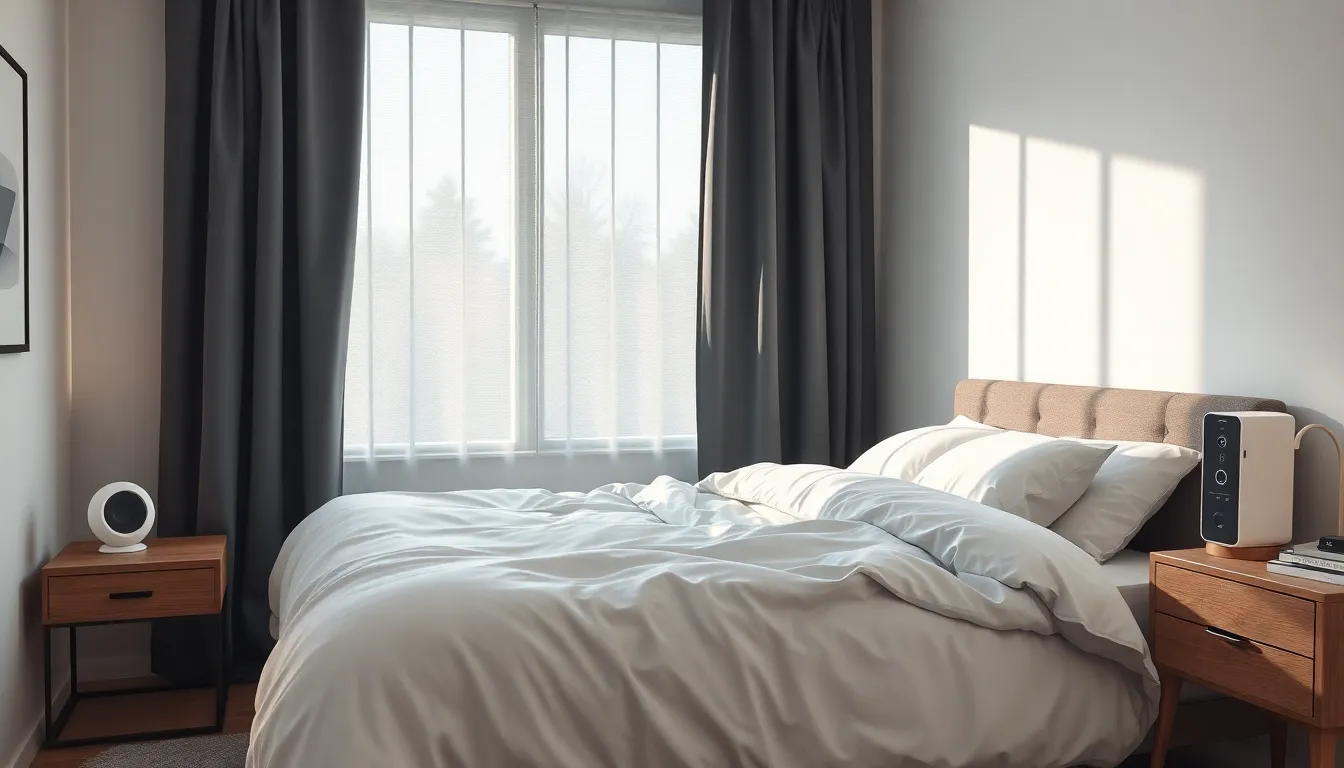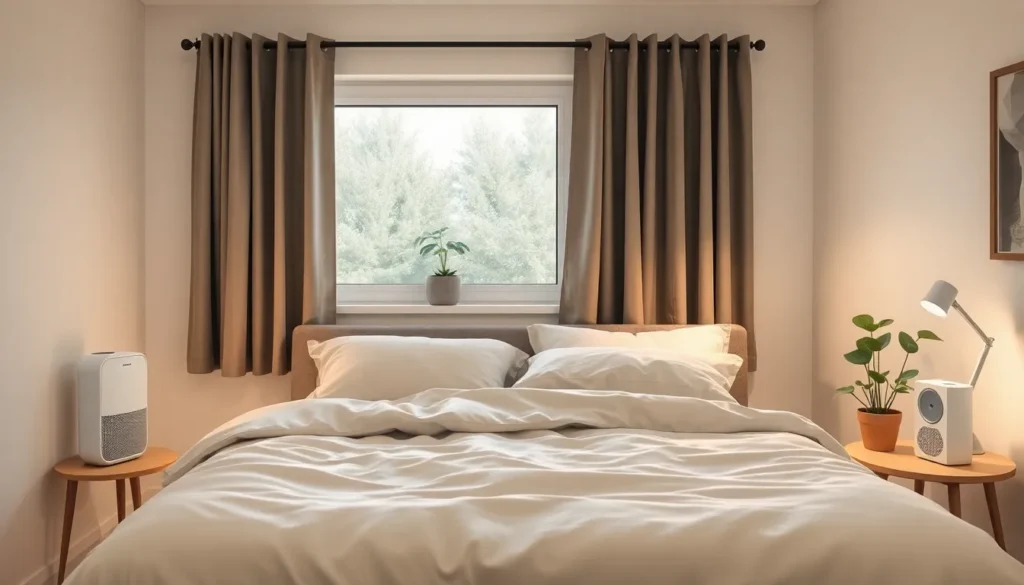A good night’s sleep is like finding a unicorn in your backyard—rare and magical. Yet many people toss and turn, battling their pillows like they’re in a wrestling match. What if the secret to that elusive slumber lies in optimizing sleeping conditions? It’s time to turn your bedroom into a sleep sanctuary that even the Sandman would envy.
Table of Contents
ToggleImportance Of Optimizing Sleeping Conditions
Optimizing sleeping conditions plays a critical role in achieving restorative sleep. Quality sleep influences overall health, mood, and cognitive function. An environment conducive to rest promotes relaxation and allows the body to recover.
Temperature affects sleep quality considerably. Ideal bedroom temperatures range from 60 to 67 degrees Fahrenheit. Maintaining this range enhances comfort and reduces disturbances throughout the night. Furthermore, light exposure significantly impacts sleep cycles. Blocked light from street lamps or electronic devices can disrupt melatonin production. Using blackout curtains or sleep masks helps create an optimal environment for deep sleep.
Noise levels also require attention. People exposed to loud noises often experience interrupted sleep patterns. Soundproofing rooms or using white noise machines can help mitigate these disturbances. Comfortable bedding is equally important. Mattress firmness and pillow selection can affect spinal alignment and support. A good mattress typically lasts 7 to 10 years and contributes to better sleep quality.
Air quality greatly influences sleep as well. Proper ventilation reduces allergens, smoke, and dust. Utilizing air purifiers can improve air quality, promoting clearer breathing during sleep. Routine cleaning of bedding and carpets can significantly reduce sleep disruptions caused by allergens.
Creating a consistent sleep schedule complements these optimizations. Going to bed and waking up at the same time each day supports the body’s internal clock. Incorporating relaxing bedtime rituals, like reading or meditation, can also enhance the sleeping experience. Each of these components works together to create a sanctuary that greatly improves sleep quality.
Factors That Affect Sleep Quality

Optimizing various elements within the sleeping environment greatly enhances sleep quality. Key factors include room temperature, lighting, and noise levels.
Room Temperature
Maintaining a comfortable room temperature contributes significantly to better sleep. The ideal range lies between 60 to 67 degrees Fahrenheit. Fluctuations outside this range can lead to discomfort, hindering restful slumber. A cooler environment encourages the body to drop its core temperature, which is essential for sleep. Using appropriate bedding and pajamas can help regulate body heat during the night.
Lighting
Light exposure plays a critical role in signaling the body when to sleep. Blackout curtains or sleep masks minimize bright light, aiding in the production of melatonin. Avoiding screens, such as phones and laptops, before bedtime also reduces disruptive blue light. Dimming lights a few hours before sleep prepares the body for rest. Creating a dark, serene atmosphere encourages relaxation and signals it’s time to unwind.
Noise Levels
Sound levels in the sleeping environment can either facilitate or obstruct sleep. Quiet rooms support a deeper sleep cycle, while disturbances can cause frequent awakenings. Soundproofing materials and white noise machines help to mask disruptive sounds. In addition, establishing a calm nighttime routine can promote a quieter atmosphere. By prioritizing a peaceful environment, individuals enhance their chances for uninterrupted sleep.
Tips To Optimize Sleeping Conditions
Optimizing sleeping conditions involves several strategic elements. Adjustments made in the bedroom can significantly enhance sleep quality.
Choosing The Right Mattress
Selecting the right mattress is essential for achieving restful sleep. Mattresses that support spinal alignment help reduce discomfort and disturbance during the night. A medium-firm mattress often strikes the right balance for most sleepers. Personas with specific needs, such as back pain, might benefit from targeted support features. Testing mattresses in-store can provide insight into personal preferences, though online reviews assist in making informed decisions when purchasing.
Selecting Comfortable Bedding
Comfortable bedding drastically improves sleep quality. Sheets made from natural materials, such as cotton or bamboo, enhance breathability and comfort. Thread count plays a role; higher thread counts often lead to a softer touch. Pillows should provide adequate neck support, promoting proper alignment throughout the night. Fluffy, down-filled pillows adapt well to head and neck shapes, catering to various sleep positions.
Creating A Relaxing Environment
Creating a relaxing environment sets the stage for quality sleep. Dim lighting in the bedroom promotes melatonin production, signaling to the body that it’s time to wind down. Incorporating soothing colors on walls and decor fosters a tranquil ambiance. Plants or essential oil diffusers add calming scents that can improve air quality. Reducing clutter in the sleeping area eliminates distractions and contributes to a serene atmosphere.
Impact Of Technology On Sleep
Technology significantly affects sleep quality, primarily through blue light exposure and sleep tracking devices.
Blue Light Exposure
Blue light emitted from screens disrupts the body’s natural circadian rhythm. Exposure to devices like smartphones and tablets before bedtime reduces melatonin production, leading to difficulty falling asleep. Studies have shown that limiting screen time during the evening improves sleep onset and overall duration. Using blue light filters or apps can also help mitigate this impact. Consider establishing a screen-free period of at least one hour before sleep to promote healthier sleep patterns.
Sleep Tracking Devices
Sleep tracking devices offer valuable insights into sleep patterns and quality. These gadgets, ranging from wearable fitness trackers to smart mattresses, monitor movement, heart rate, and sleep stages. By analyzing this data, individuals can identify habits that impact sleep quality and make necessary adjustments. Some devices also provide recommendations for improving sleep hygiene. Regularly reviewing this information encourages conscious decisions about sleep environment and routines, resulting in better rest.
Optimizing sleeping conditions is essential for achieving restorative sleep and enhancing overall well-being. By focusing on factors like temperature, light, noise, and bedding, individuals can create an inviting sleep sanctuary. Implementing simple changes such as using blackout curtains and maintaining a cooler room temperature can significantly improve sleep quality.
Incorporating relaxing bedtime rituals and managing technology use further supports a restful environment. With the right strategies in place, anyone can transform their bedroom into a peaceful retreat that promotes better sleep. Prioritizing these adjustments not only leads to improved rest but also positively impacts health, mood, and cognitive function.



